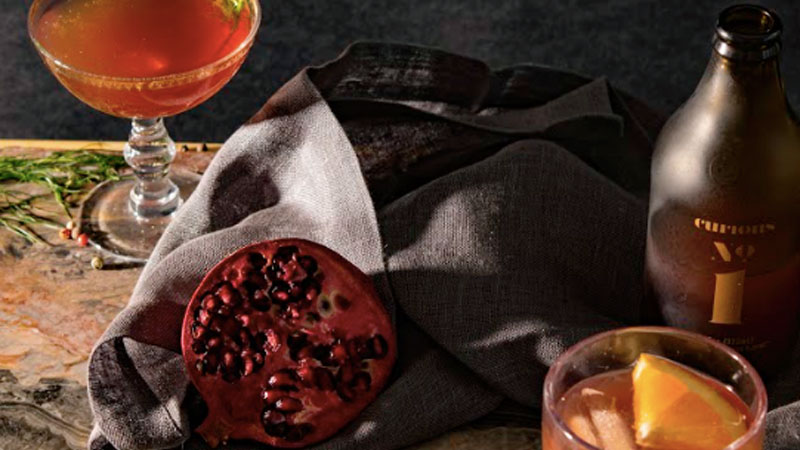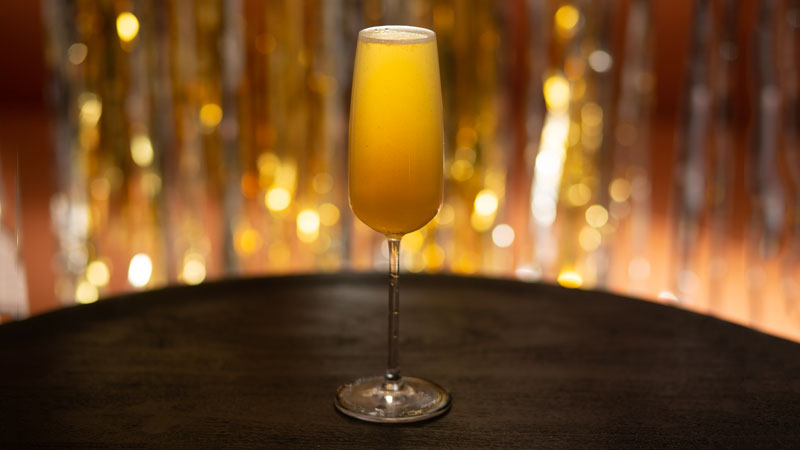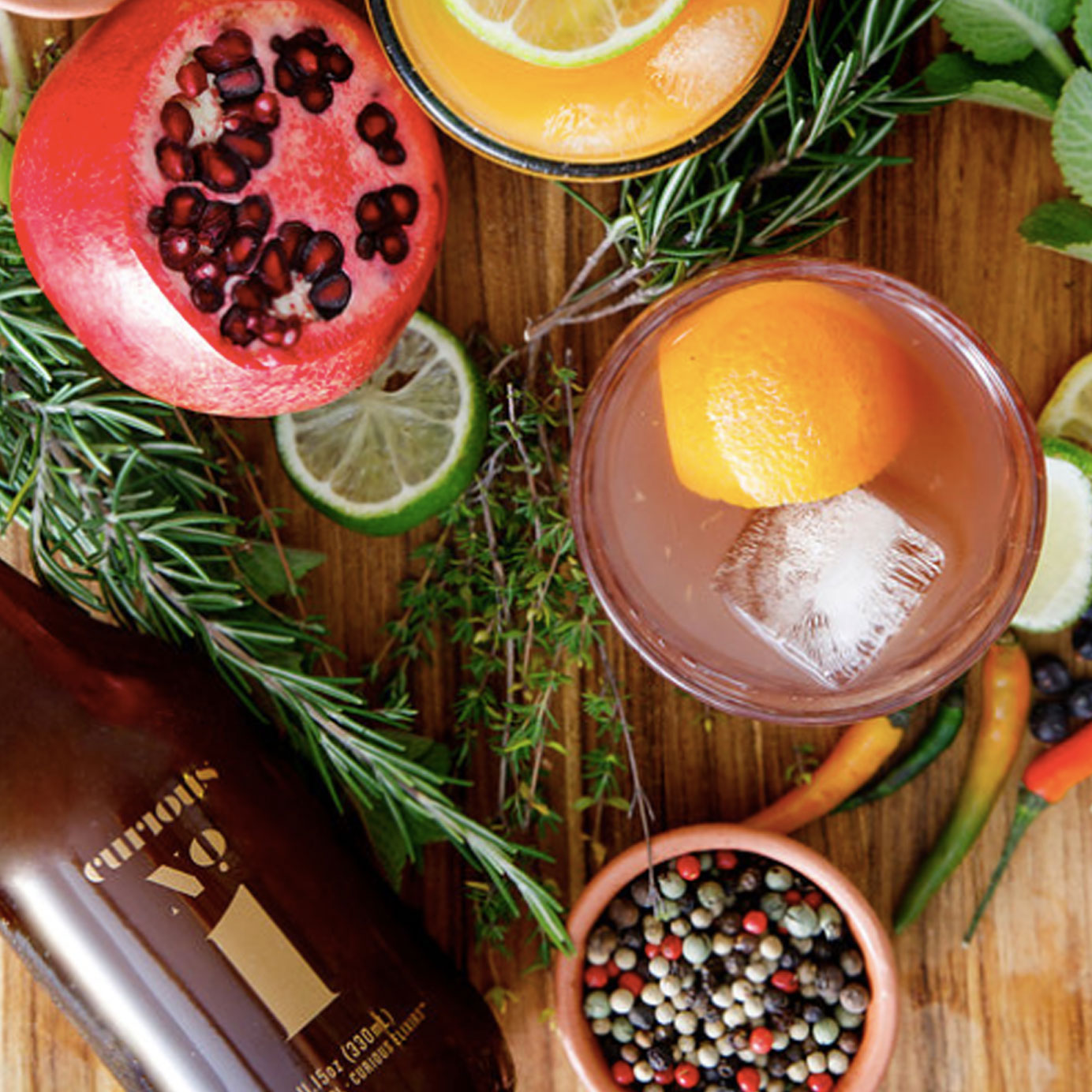There are plenty of reasons to not drink at a party. Maybe GOOP passive-aggressively commanded it. Maybe you don’t drink, never drank, or just quit. Maybe Kyle is at the party, and last time you saw Kyle you drunkenly tried to braid his beard (and you know Kyle would just love Sober You).
Whatever your reasons for abstaining, chances are your dry options are paltry, especially at a party, where focus and finances tend to go to booze and prosciutto-wrapped foodstuffs. Soft drinks are a socializing afterthought, typically carb-dense and dull.
That’s changing. Or, rather, evolving — you might remember the rise of the sugar-monster “Mocktail.” Now, instead of super-sweet concoctions rivaling a TGI Friday’s indulgence, what we have is a consumer-driven renaissance of thoughtfully made, 0 percent ABV drinks.
Bartenders across the country are justifying higher price tags as they dole out alcohol-free drinks with names like Get Smashed, a feature on the Temperance menu at River Roast in Chicago. Reception, a new Korean-American cocktail and “elixir” bar in NYC, has as many non-alcoholic drinks as traditional cocktails on its list. The former are presented as riffs on Korean home remedies and include the likes of Buckwheat Bubbly, a buckwheat-chrysanthemum sparkler with goji berries.
More exciting still is the roster of products now available to non-drinkers. These sodas, syrups, and even non-alcoholic “spirits” are perfect for those who are tired of toasting sobriety with Pepsi while their friends get sloppy.
On behalf of karaoke-enduring, white-knuckle-sober people everywhere, a primer on how to master the non-alcoholic options for your next party.
Water (No, Seriously)
No one is telling you to get a $344 water decanter. Sure, its semi-precious gemstones vibrate at just the right frequency to alkalinize your water to 8.02, but, let’s be honest, exactly four people in the world know or care what that means. Unless one of them is a friend of yours, save your Benjamins for other pursuits.
Instead, invest (modestly) in a sparkler like San Pellegrino, and/or trick out your SodaStream with DIY garnishes and infusions. Swap lime wedges for seasonal fruits, or sprigs of savory herbs like rosemary for sparkling. Or go for an eco-friendly BPA-free boxed water and enjoy the natural buzz of ethical living.
Sparklers
Somebody shoot confetti out of a canon — we’re living in the golden age of artisan soda. Craft soda sales have been rising since 2011.
According to USA Today, in a perpetual quest to self-differentiate, “affluent Millenials” seek out individuality via soda (i.e., all the money we don’t spend on crippling debt or rent hikes goes directly to sodas with names like Juniper Valley Artisan Root Beer, “now with hand-crumbled Fair Trade Sarsparilla”). Whatever the cause, your soda aisle is busting with names like Belvoir, Q, Flying Cauldron, Dry Sparkling, Fever Tree, Izze, Blue Sky, etc. The trick is looking for sugar content — lurking under label quaintness could basically be Mountain Dew with a folksy name.
“There’s so much one-note sweetness out there,” Mary Pellettieri, co-founder of Top Note Tonic in Milwaukee, says. “People want sweet, sour, salty, and bitter — a balance. That sophistication is missing in beverage.”
Top Note’s growing roster of products, which Pellettieri and partner Noah Swanson introduced in 2014, fills the void with options like Bitter Lemon soda, Ginger Beer with date sugar, and Indian Tonic Water with bright sparks of citrus peel over woodsy gentian root and quinine.
Complexity is ideal for non-alcoholic drinking options because it’s mentally engaging (which is good, because you’re not as funny as you think you are, Drunk Steve).
“Science seems to show that our brain actually likes to think about flavor, whether or not we’re conscious of it,” Pellettieri says. (She’s right.) Bonus points: Tonics like Pellettieri’s do double duty as standalone ABV-free drinks and cocktail mixers. “We designed them all to be consumed without alcohol,” she says, but you can add it if you like.

(Faux) Spirits
“Everybody should be able to get a great drink regardless of the alcohol content. Full stop.” So says Ben Branson, creator of Seedlip Drinks, the self-proclaimed “world’s first distilled non-alcoholic spirit.”
Branson, who just so happens to come from an 18th-century British agricultural legacy, didn’t start Seedlip in 2015 to make an excuse for gentlemanly vest-wearing (though it helps). He believes in the canon of creative non-alcoholic drinks, and is genuinely surprised it’s taken us so long to get here.
“It’s incredible no one’s done anything about it,” Branson says. “But now there’s this paradigm shift in terms of how we live our lives, what’s important to us, and some of that’s obviously from the wellness boom, the internet and how hyper-connected the world is now. It is definitely forcing a recalibration of how much people drink.”
In Branson’s case, a green thumb and a 1651 copy of “The Art of Distillation” yielded a mini U.K.-based revolution in non-alcoholic drinking. Proximate to — but never chasing — options like gin and whiskey, Seedlip’s Garden 108, Spice 94, and just-launched Grove 42 begin with spices, produce and botanicals, water, and alcohol (it’s better at extracting flavor), but the final product is distilled to be entirely non-alcoholic.
“I’m never thinking about ABV,” Branson says. “It’s kind of that complete freedom — to be able to really concentrate on flavor.” At the moment Seedlip is arguably the most visible — and available — spirit-similar option out there. It’s available online; or, if you happen to be living large in Napa, it’s on the menu at The French Laundry.
Bottle Service
As thirst for “non-alc” intensifies, more and more products are catering to it. There’s even a company that just funds non-alcoholic start-ups!
This means there are now bottled non-alcoholic cocktails, like Curious Elixirs, a Beacon, N.Y., company that launched in 2016. Its drinks are all 100 percent organic. Curious No.2, which is made with orange, pineapple, and lime juice concentrates, plus chili extract, is a distant cousin of a spicy Margarita.
There are also plenty of sideline products and ingredients created for cocktails but just as useful in dry drinking, like Grapefruit Basil and Cucumber Habanero simple syrups from Ohio-based Not So Simple Syrups, or vinegar-like Blueberry Lemon and Apple Ginger shrubs from Twisted Shrub in Minneapolis.
Just because you’re not drinking alcohol doesn’t mean you can’t raid the cocktail cabinet. Berkeley-based Shrub & Co.’s products were “crafted for cocktails” by bartenders, fine, but those bartenders aren’t in your apartment, and they can’t stop you from using their Organic Yucatan Honey and Douglas Fir-Infused Cranberry shrubs to blow sober minds at your next Yahtzee night.
Hit up your local Whole Foods or similarly virtue-signaling grocery store, and you’ll find rows and rows of stuff like kombucha (which, FYI, can contain trace alcohol) and cold brew (which Pellettieri notes goes nicely with her Indian Tonic with a bit of lemon rind). Even cranberry juice works — but the good stuff, the high-test concentrate with a puckery slap in the face of acidity wrapped up in tight, ruby-red tannins.
Pantry Items
The 0 percent ABV menu at San Francisco’s aptly named ABV Bar offers a great template for how to raid your kitchen cabinets for non-alcoholic ingredients. Infuse jarred (or fresh!) tarragon into simple syrup to spike boozy and non-proof drinks alike, and squeeze fresh citrus to spike your sodas.
Branson also suggests things like chutneys or jams. “You can just throw it in and bring some good viscosity,” he says. This is an especially beneficial addition since typically the only body you’ll get in dry drinks is carbonation (and bubbles, God bless them, can only do so much). But add jam or honey to your drink, shake it to emulsify, and you’ll get fleshiness and substantive weight.
Stocking your non-alcoholic bar is also a great way to flaunt (er, share) seasonal bounty, or salvage the contents of your crisper drawer.
“I typically use my garden,” says Branson. Fresh herbs and produce are economical, as are forgotten spices and baking extracts, all of which are easy enough to stir into simple syrup while you do Keto meal prep for the week. There are even non-alcoholic cocktail recipe books like “Dry” from Clare Liardet to guide you.
“I don’t think it’s a passing phase, from everything I see globally,” says Branson. “We’re working on the ratios for the non-alcoholic world at the moment. Lots of people keep telling me, ‘Sober is the new black.’”

Non-Alcoholic Cocktail Recipe
Want to mix up something special without the buzz? Katie Rue, of NYC cocktail and elixir bar Reception, adapted the recipe for this non-alcoholic cocktail, the Buckwheat Bubbly, for home bartenders.
Ingredients:
- ½ ounce freshly squeezed lemon juice
- ½ oz goji berry honey (available at health food stores and via Amazon)
- 3 ounces chrysanthemum tea, brewed and cooled
- 2 ounces buckwheat tea, brewed and cooled
- Lemon twist for garnish
Directions:
- First, make the sparkling teas. Rue built her own carbonation machine at Reception that she uses at the bar to carbonate various teas used in some of the elixirs. At home, you can use a SodaStream or other carbonation device to sparkle room-temperature buckwheat and chrysanthemum teas.
- Combine all ingredients in a Champagne flute.
- Gently stir, so as to not disrupt bubbles.
- Garnish with a lemon twist.
